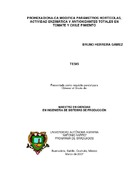Mostrar el registro sencillo del ítem
Prohexadiona-ca modifica parámetros hortícolas, actividad enzimática y antioxidantes totales en tomate y chile pimiento
| dc.contributor.advisor | Ramírez Rodríguez, Homero | |
| dc.contributor.author | Herrera Gámez, Bruno | |
| dc.contributor.other | Benavides Mendoza, Adalberto | |
| dc.contributor.other | Villarreal Quintanilla, José Ángel | |
| dc.creator | Herrera Gámez, Bruno | |
| dc.creator | Ramírez Rodríguez, Homero | |
| dc.creator | Benavides Mendoza, Adalberto | |
| dc.creator | Villarreal Quintanilla, José Ángel | |
| dc.date.issued | 2007-03 | |
| dc.identifier.uri | http://repositorio.uaaan.mx:8080/xmlui/handle/123456789/3839 | |
| dc.description | Determinar e identificar el contenido de giberelinas endógenas en ápices de plántulas de tomate saladette y chile pimiento al aplicar prohexadiona de calcio. Evaluar los efectos de P-Ca en el crecimiento y desarrollo hortícola en plantas de tomate bola variedad Floradade. Evaluar los efectos de prohexadiona de calcio en parámetros postcosecha del fruto de tomate bola variedad Floradade. | |
| dc.description.abstract | "Con el propósito de evaluar el efecto de prohexadiona de calcio (P-Ca) en el contenido endógeno de giberelinas en ápices de tomate saladette (Lycopersicon esculentum Mill.) y chile pimiento (Capsicum annuum L.), se aplicaron 3 dosis del retardante (125, 175 y 200 mg·litro-1) y un testigo (H2O) en ambas hortalizas en el estadio de plántula con seis hojas verdaderas. Los ápices se cosecharon los días 0, 1, 3 y 6 después de haber realizado la aplicación de los tratamientos, las muestras se liofilizaron para su análisis en laboratorio. Se realizaron análisis cuantitativo y cualitativo de giberelinas, mediante cromatografía de gases y espectrometría de masas. Se encontró que 22 los ápices de tomate saladette tratados con P-Ca mostraron un menor contenido de las giberelinas A4 y A7 a partir del siguiente día de haberse aplicado los tratamientos. Esta tendencia fue consistente hasta el sexto día de evaluación. Resultados similares se registraron con los ápices de chile pimiento. Los análisis de cromatografía de gases y espectrometría de masas, permitieron identificar en ápices tratados con P-Ca la giberelina A20 en tomate saladette, mientras que las giberelinas A20 y A53 estuvieron presentes en chile pimiento. En los ápices testigo de ambas hortalizas, se encontraron las giberelinas A1, A4 y" | |
| dc.format | ||
| dc.language | Español | |
| dc.publisher | Universidad Autónoma Agraria Antonio Narro | |
| dc.rights | Acceso Abierto | |
| dc.rights.uri | CC BY-NC-ND - Atribución-NoComercial-SinDerivadas | |
| dc.subject | CIENCIAS AGROPECUARIAS Y BIOTECNOLOGÍA | |
| dc.subject.other | Tomate | |
| dc.subject.other | Chile pimiento | |
| dc.subject.other | Antioxidante | |
| dc.title | Prohexadiona-ca modifica parámetros hortícolas, actividad enzimática y antioxidantes totales en tomate y chile pimiento | |
| dc.type | Tesis de maestría | |
| dc.description.abstractEn | "The present investigation was conducted in two phases In the first phase, this study was carried out with the purpose of learning the effects of prohexadione-calcium (P-Ca) on the levels of endogenous gibberellins in tomato saladette (Lycopersicon esculentum Mill.) var. Río Grande and bell pepper (Capsicum annuum L.) var. Capistrand shoot apex. The growth retardant was sprayed at three dosages (125, 175 and 200 mg L-1) to both vegetables crops when six true leaves appeared in growing seedlings. A control treatment was included in each crop species. Shoots apex were collected at 0, 1, 3 and 6 days after treatments. Results showed that tomato saladette apex sprayed with P-Ca reflected less gibberellins A4 and A7 from the first day on words after treatment. This tendency was similar in bell pepper samples. The gas chromatography and mass spectrometry analysis allowed to identify gibberellin A20 in tomato, and gibberellins A20 and A53 in bell pepper samples from P-Ca treated plants. The gibberellins A1, A4 and A7 were detected in control samples. In the second phase, a study was conducted with the purpose of learning the effects of prohexadione-ca (P-Ca) on vegetative, reproductive and postharvests parameters, the total antioxidant and lycopene content as well as the enzymatic activity in plants and during fruit ripening in tomato Floradade. The growth retardant was sprayed to experimental plants in one or/and in two occasions. The first application was done when plants had reached 50% blossom; whereas, the second one was performed two weeks after. The concentration dosages of P-Ca were control , 125, 175 and 200 mg L-1. The height of the plant was reduced remarkably with the applications of P-Ca, showing a noticeable reduction in the height as the dosage is increased. P-Ca increased the number of clusters and fruits by plant. The firmness in the fruit was increased by effect of the retardant. The number of flowers, percentage of fruit set, diameter of the stem, number of nudes, production by plant and the radius of the fruit did not show an effect before the applications of P-Ca. The fresh and dry weight of the plant, the total soluble solids and weight of the fruit were reduced by effect of PCa. The results showed that any treatment with P-Ca increased the total antioxidant capacity in evaluated fruits at different stages of fruit ripening. The content of lycopene showed a remarkable increment in ripen fruits harvested from plants which have received the P-Ca applications. The activity of catalase and peroxidase also increased in these tomato fruits treated with the growth retardant." | |
| dc.type.version | Versión publicada | |
| dc.audience | Estudiantes | |
| dc.audience | Investigadores | |
| dc.publisher.place | Saltillo, Coahuila, México | |
| dc.type.thesis | Digital |
